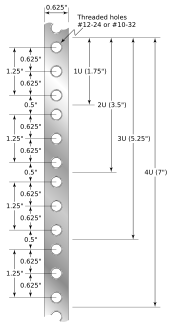List of unusual units of measurement
An unusual unit of measurement is a unit of measurement that does not form part of a coherent system of measurement, especially because its exact quantity may not be well known or because it may be an inconvenient multiple or fraction of a base unit.
This definition is not exact since it includes units such as the week or the light-year, which are quite "usual" in the sense that they are often used but which can be "unusual" if taken out of their common context, as demonstrated by the furlong-firkin-fortnight (FFF) system of units.
Many of the unusual units of measurements listed here are colloquial measurements, units devised to compare a measurement to common and familiar objects.
Length[]
Hammer unit[]
Most computer programs and games use meters as the base unit to represent length, but some do not. One of the most common units used in software, that is unusual elsewhere, is the Hammer unit, a unit of measurement used in Valve's Source engine.[1] One Hammer unit is usually defined as a sixteenth of a foot (16 Hammer units = 1 foot). This means that one Hammer unit is equal to exactly 0.01905 meters, and one meter is equal to 52.49344 Hammer units. This scale is not rigidly enforced in all Source games; each game has its own rules of how big things are that slightly differ from this standard. Another program that can use a unit similar to Hammer units is 3DS Max.[2][3]
Rack unit[]

One rack unit (U) is 1.75 inches (44.45 mm) and is used to measure rack-mountable audiovisual, computing and industrial equipment. Rack units are typically denoted without a space between the number of units and the 'U'. Thus a 4U server enclosure (case) is seven inches (177.8 mm) high, or more practically, built to occupy a vertical space seven inches high, with sufficient clearance to allow movement of adjacent hardware.
Hand[]
The hand is a non-SI unit of length equal to exactly 4 inches (101.6 mm). It is normally used to measure the height of horses in some English-speaking countries, including Australia,[4] Canada, Ireland, the United Kingdom, and the United States.
Light-nanosecond[]
The light-nanosecond is defined as exactly 29.9792458 cm. It was popularized in information technology as a unit of distance by Grace Hopper as the distance which a photon could travel in one billionth of a second (roughly 30 cm or one foot): "The speed of light is one foot per nanosecond."[5][6]
Metric foot[]
A metric foot (defined as 300 mm, or about 11.8 inches) has been used occasionally in the UK[7] but has never been an official unit.
Horse[]
Horses are used to measure distances in horse racing – a horse length (shortened to merely a length when the context makes it obvious) equals roughly 8 feet or 2.4 metres. Shorter distances are measured in fractions of a horse length; also common are measurements of a full or fraction of a head, a neck, or a nose.[8]
Boat length[]
In rowing races such as the Oxford and Cambridge Boat Race, the margin of victory and of defeat is expressed in fractions and multiples of lengths. The length of a rowing eight is about 62 feet (19 m). A shorter distance is the canvas, which is the length of the covered part of the boat between the bow and the bow oarsman. The Racing Rules of Sailing also makes heavy use of boat lengths.
Football field (length)[]
A football field is often used as a comparative measurement of length when talking about distances that may be hard to comprehend when stated in terms of standard units.
An American football field is usually understood to be 100 yards (91 m) long, though it is technically 120 yards (110 m) when including the two 10 yd (9.1 m) long end zones. The field is 160 ft (53 yd; 49 m) wide.[9]
A Canadian football field is 65 yd (59 m) wide and 150 yd (140 m) long, including two 20 yd (18 m) long end zones.
Media in the UK also use the football pitch as a unit of length, although the area of the association football pitch is not fixed, but may vary within limits of 90–120 m (98–131 yd) in length and 45–90 m (49–98 yd) in width. The usual size of a football pitch is 105 m × 68 m (115 yd × 74 yd), the dimensions used for matches in the UEFA Champions League.
Block[]
In most US cities, a city block is between 1⁄16 and 1⁄8 mi (100 and 200 m). In Manhattan, the measurement "block" usually refers to a north–south block, which is 1⁄20 mi (80 m). Sometimes people living in places (like Manhattan) with a regularly spaced street grid will speak of long blocks and short blocks. Within a typical large North American city, it is often only possible to travel along east–west and north–south streets, so travel distance between two points is often given in the number of blocks east–west plus the number north–south (known to mathematicians as the Manhattan Metric).[10]
The Earth's radius[]
The radius of Earth, generally given as 6,371 kilometers (3,959 miles) is often employed as a unit of measure to intuitively compare objects of planetary size. The unit is commonly written as r